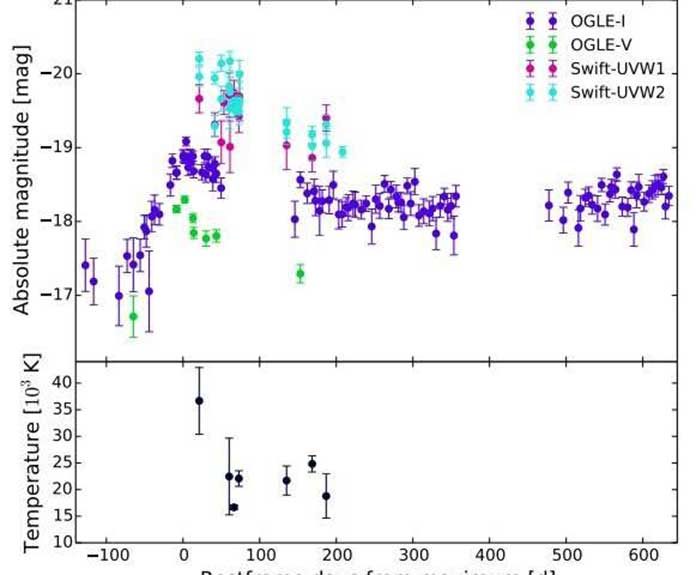An international group of astronomers has recently spotted an unusual nuclear transient in the nucleus of a weakly active galaxy using the OGLE-IV Transient Detection System and received designation OGLE17aaj.
Astronomers spotted this peculiar nuclear transient event in the nucleus of the galaxy GALEXASC J015624.70-710415.8, some 680 light years away from the center of the host.
OGLE17aaj was detected by the OGLE-IV Transient Detection System in January 2017 and follow-up observations of this transient were performed subsequently using various ground-based and space telescopes.
Astronomers noted, “We report on the discovery and follow-up of a peculiar transient, OGLE17aaj, which occurred in the nucleus of a weakly active galaxy.”
OGLE17aaj was detected at a host-subtracted I-band magnitude of about 21.0 and reached an I-band maximum magnitude of 20.0 in about 60 days. A while later, the transient declined for around 200 days and seems to have achieved a level. The evaluated peak absolute magnitude of OGLE17aaj in the I-band was found to be 18.8 was observed to be 18.8.
Results from ultraviolet measurements of OGLE17aaj follow the trend seen in optical observations. The astronomers noted that at maximum, the transient reached a magnitude of 19.06, and 18.52 on galaxy-subtracted images from NASA’s Swift space telescope.
Moreover, the scientists calculated the lower limit on the total energy emitted by OGLE17aaj until now. This value is at a level of approximately 7.0 sexdecillion ergs, what corresponds to a lower limit of the accreted mass of about 0.04 solar masses.
Astronomers noted, “We investigated it as a potential TDE candidate based on its high black-body temperature and on the similarity of its spectrum to that of the recently reported nuclear event in F01004-2237, which was interpreted as a TDE. (…) OGLE17aaj showed a well-covered 60-day-long rise and a slow 200-day decline, followed by a plateau until day 300. This is unlike any TDE reported so far.”
The finding is reported in a paper published January 11 on the arXiv pre-print repository.
